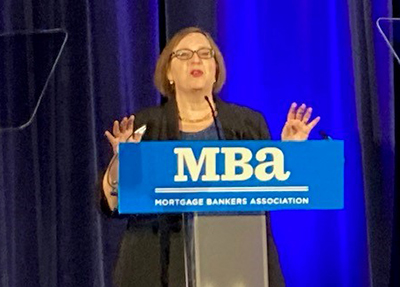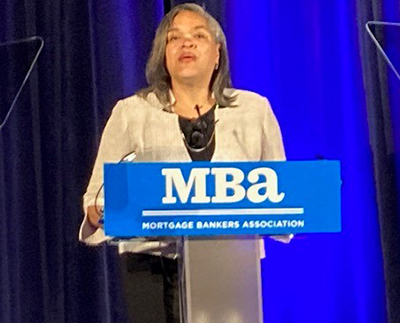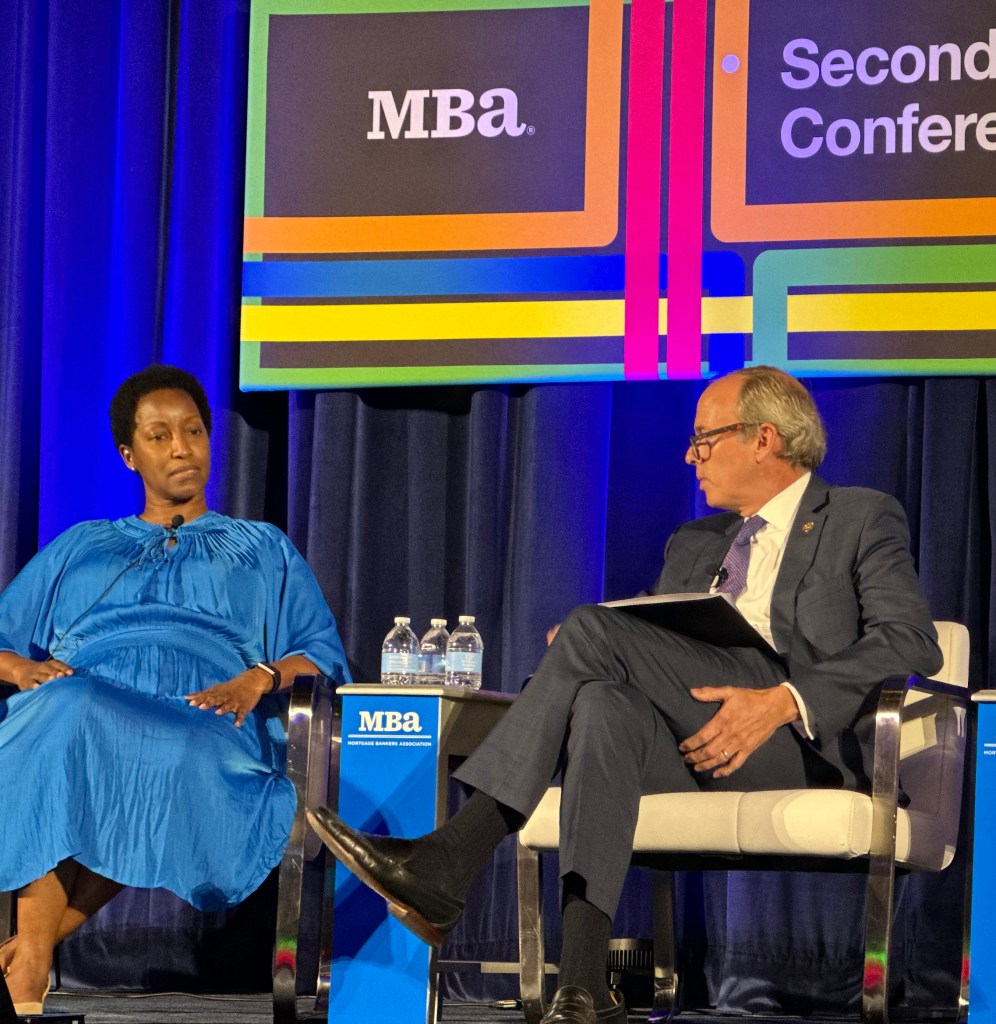
MBASecondary23: A Look Ahead at Government Lending

(Assistant Secretary for Housing and Federal Housing Commissioner Julia Gordon)
NEW YORK–Leaders of FHA, the Federal Housing Finance Agency and Ginnie Mae shared recent developments and their outlook for future policies and activities here at the Mortgage Bankers Association’s National Secondary Market Conference & Expo.

“The MBA Secondary Conference is a great place to come back to every year, because you are the reason we were created,” said Alanna McCargo, President of Ginnie Mae.
Naa Awaa Tagoe, Deputy Director of the Division of Housing Mission and Goals with FHFA, acknowledged MBA for its “thoughtful feedback” on FHFA’s recently announced Single-Family Pricing Framework, but defended what she termed “a fair amount of misunderstandings” on the framework’s objectives.
“As the regulator of Fannie Mae, Freddie Mac and the Federal Home Loan Banks, FHFA has a twin mandate of, ensuring that our regulated entities operate in a safe and sound manner and, ensuring that they support access to safe and affordable housing across the nation,” Tagoe said. “The objectives of the changes to the single-family pricing framework touch on both aspects of our mandate.”

The first objective of the pricing changes, Tagoe said, is safety and soundness. The second objective is to support access to affordable housing, for creditworthy low-and-moderate income homeowners, many of whom are first-time homebuyers.
“As we are all painfully aware, over the past several years homeownership has become increasingly unaffordable for many Americans, particularly for those on low and moderate incomes,” Tagoe said. “We also know that homeownership is a critical step to building wealth for families and that the Enterprises were created to support, some would even say, expand, sustainable homeownership. Bear in mind that the Enterprises’ single-family upfront fees had not been updated for several years. Since 2015. So, with this context and those two objectives in mind, safety and soundness and supporting access to mortgage credit for creditworthy borrowers, FHFA announced a series of updates to the single-family pricing framework starting last year. “
Tagoe said taken together, “these pricing changes improve the Enterprises’ ability to support access to mortgage credit, while continuing to ensure a level playing field for small and large sellers, fostering capital accumulation, and moving the Enterprises directionally towards achieving viable returns on capital.”
McCargo said Ginnie Mae continues to see a strong appetite for mortgage servicing rights. “Our system is stronger because of our issuers, and we count on you to ensure our success in managing risk. We are in a stressful market cycle—it is critical that we support our issuers. If the recent turmoil in the financial sector tells us anything, it’s that we have to take a market-driven approach; we are looking at the long-term.”
McCargo noted the GSEs have been enabling eMortgages for some time. “Ginnie Mae is all in on this technology,” she said. “We have moved from pilot program to full program in the past year and we will continue to invest in transformational technology. It’s important that we keep pace with the market, and I believe we are well-positioned for the future.”
Ginnie Mae has also made a strong investment in Environmental, Social and Governance (ESG) over the past year. “We’ve made clear through our data disclosures, and it’s clear from our investors that they want more ESG investment opportunities to meet their ESG goals,” McCargo said. “Our investors know what they’re getting when they buy a Ginnie Mae bond; we have executed memorandums of understanding with some of our largest investors to help them meet their ESG goals through us. We believe this can help us meet the needs of our low- and moderate-income borrowers as well.”
McCargo also sees a role in improving housing supply. “We need more housing in the market,” she said. “We’re working with FHA to ease Title I program requirements for manufacturing. There is a lot of space in the manufacturing and Accessory Dwelling Unit industry for us to be in. We also believe there is an opportunity for Ginnie Mae to support more risk-sharing with state housing finance agencies—this can be a win-win.”
Julia Gordon, Assistant Secretary for Housing and Federal Housing Commissioner, said many households have not recovered from the pandemic, “particularly those underserved borrowers who make up our base.”
“That’s part of the cyclical nature of the business,” Gordon said. “But it’s also an opportunity: providing financing to well-qualified lower-income individuals is our mission. Eighty-two percent of our borrowers last year were first-time homeowners. We are really servicing what is essentially the middle class of America—people who want to enter the housing market and build wealth and stability and pass that along to the next generation.”
Gordon acknowledged FHA’s decision to reduce the Mortgage Insurance Premium by 30 points—a move long-advocated by MBA—“has already seen an impact among FHA borrowers.” Additionally, the Biden Administration has proposed a $10 million program in its fiscal 2024 budget to provide down payment assistance for borrowers.
“We know the down payment is the single-biggest barrier to first-time homeownership,” Gordon said. “We are also making our own changes to our ADU policy so that borrowers can use rental income from these units to factor into their financing.”
